One of the top questions we have been getting about Spike the titan arum is “How do you know how much water to give him?”
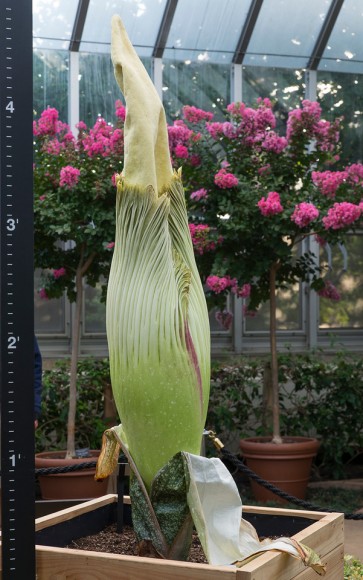
The care and feeding that we have given Spike and his fellow titan arums—our collection of nine Amorphophallus titanum growing in our production greenhouses—is very specific!
Yes, the cultivation requirements for these plants are strict. Titan arums require well-maintained conditions of high humidity and high temperature—similar to their natural conditions in the tropical rainforests of Sumatra. Therefore, the cultivation is not particularly suitable for most beginners or homeowners with minimal greenhouse facilities.
Watering the bloom
During Spike’s flowering stage, we make sure the soil is evenly moist at all times. This is important to continue flower development and prevent the spathe (the frilly modified leaf) from drying out or not opening. We also pay special attention to air humidity—we try to keep the humidity between 75 to 90 percent saturation at all times. How? We keep the floors wet and prevent excessive venting in the greenhouse.
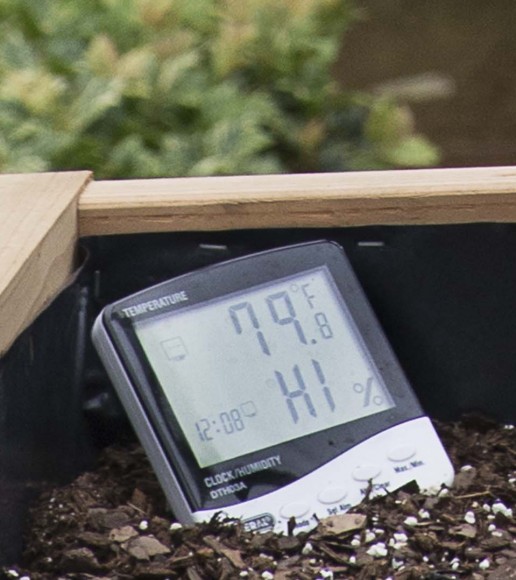
Watering for leaf growth
Spike and the rest of the collection have grown through many leaf and dormancy cycles into larger corms (a type of underground tuber or bulb). It would seem that tending the growing corms would be about as complicated as a typical bulb, but a close eye must be kept on how the corms are watered to prevent them from drying out or rotting. As the leaves grow larger each growth period (12 to 18 months), their increasingly larger corms may prevent the soil beneath them from becoming wet. Increasing watering to make sure the soil is kept moist at the bottom of the tuber could cause the corm to rot, as most of its roots develop on the upper surface. The growing medium must be evenly moist at all times, but not wet, and the soil should never dry out completely, especially at the start of leaf development. Using a loose medium and a layer of gravel drainage in the planters ensures that water reaches all parts of the corm without flooding it. Finally, we repot the corms—a lot—to make sure the soil stays evenly moist, and to give them room to grow!
Yes, we went through a lot of pots…
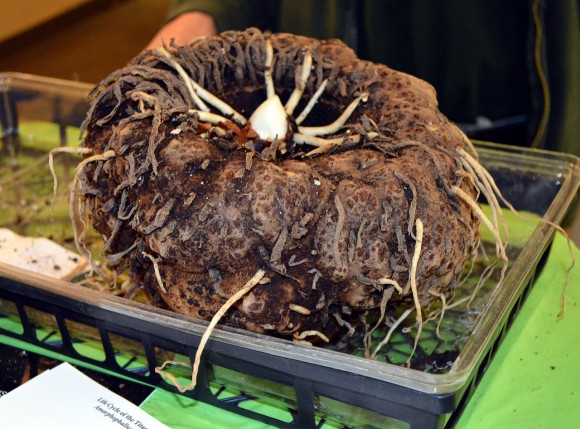
Spike was repotted many times as the corm continued to grow larger each season. In fact, several times the pots or containers that the plant was growing in would crack or break as the swelling corm beneath the soil surface would “push” outward and damage its container. Last fall, we finally had our carpenters here at the Chicago Botanic Garden make big 42″-by- 42″ wooden crates as a more permanent home to grow Spike and several others in our collection. At the end of each dormancy cycle, we carefully lift the corms, inspect them for pests or rot, and remove any unwanted new bulbils that may have formed. When moving these corms to their new homes, we provided extra drainage at the bottom of the crates by amending the soil with more perlite at the bottom and a layer of gravel.
How hot is it in here, exactly?
Not surprisingly for a Sumatran plant, Amorphophallus titanum prefer to be grown at temperatures between 70 to 85 degrees Fahrenheit during the day and 68 to 80 degrees at night—pretty warm, and without a lot of temperature fluctuation. Temperatures above 90 degrees or extreme cool temperatures may damage the foliage or flower, so we are keeping a close eye on Spike as visitors come to check on his progress.
The future’s so bright…
Spike also needs a lot of sunlight—both in leaf and flower form. We provide minimal shading to our collection (enough to prevent foliar damage), and only during the hottest summer months. Does that mean we need additional lighting to compensate for Chicago being so far north of the equator? Actually, no. No additional lighting or day length control have been necessary. The lights currently surrounding Spike in the greenhouse are for our time-lapse cameras, to make sure our star is lit evenly on his performance night!
Does Spike need a lot of fertilizer?
Definitely! Titan arums require high levels of fertilizer to be applied on a regular basis while in the leaf stage. We fertilized at every other watering, especially during the summer months, and reduced fertilization during the colder winter months. When we determined the emerging shoot of Spike was indeed a flower, however, fertilization ceased.
Are you sure you don’t know exactly when Spike will open?
We’re sure we don’t know for certain. We have key factors we look for, like the bracts (outer leaves) shriveling up and falling away 48 hours before a bloom. But this is not always the rule—in some cases, blooming is what makes the bracts finally fall away from the flower! In the end, only Spike knows when he’ll bloom.
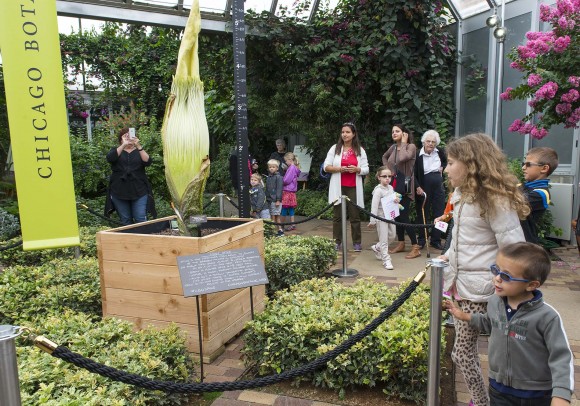
As you can see, the cultivation of our Amorphophallus titanum collection can be somewhat challenging! Providing them with the unique cultural requirements to get them to live long enough and to eventually bloom is a mighty task. However, all the extra “TLC” given by our greenhouse staff will be well worth the long wait to see Spike bloom in just a few days.
©2015 Chicago Botanic Garden and my.chicagobotanic.org

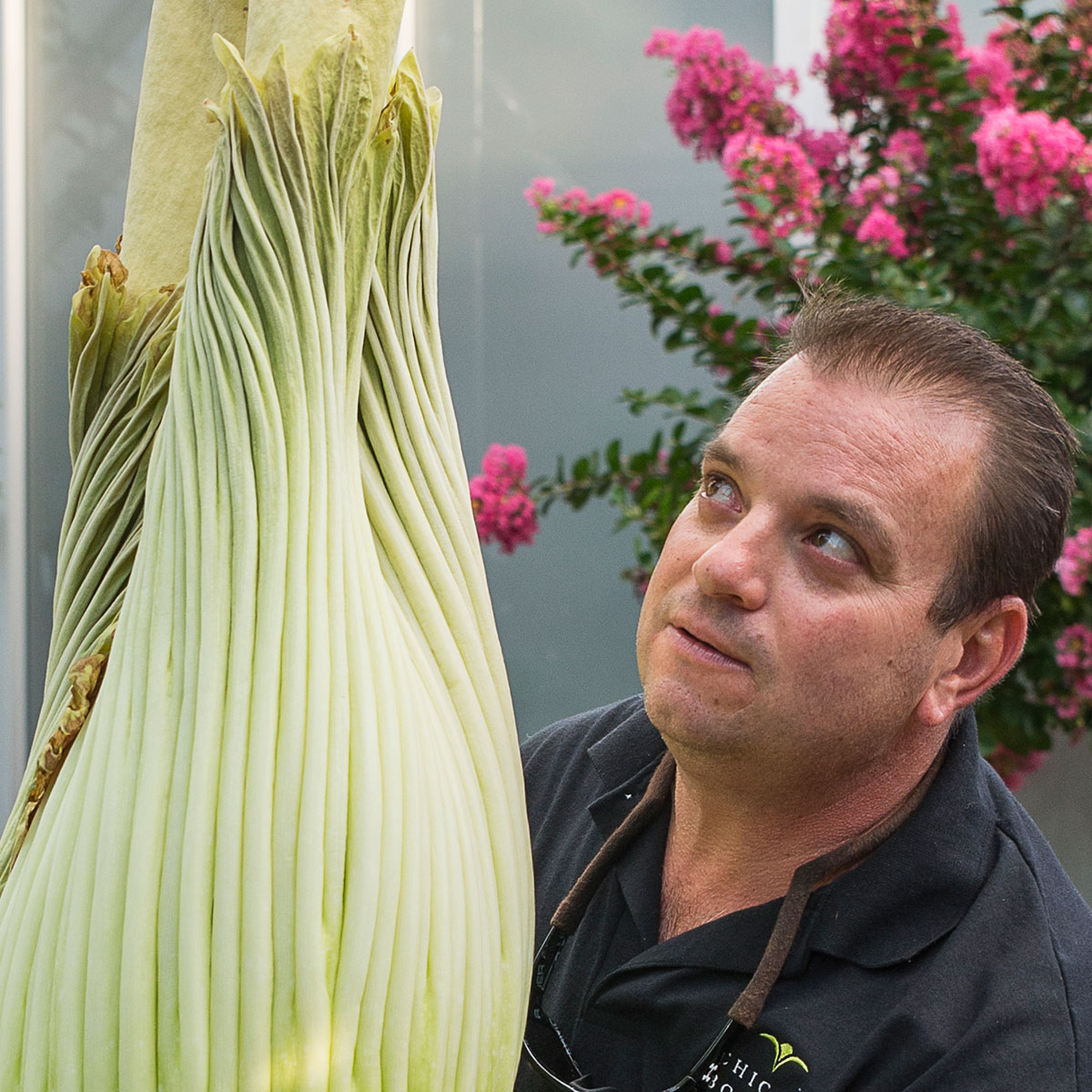
Enjoyed Tim Pollak’s helpful explanations and commentary. Thanks, Tim!
I’d love to know what the aroma of the flower is when it really blooms!
To describe it yourself, Nora, you’ll have to visit in person and take a sniff! But researchers have described it as a combination of scents, meant to mimic a carcass in a particular state of decomposition—not too old, not too fresh. This is to attract carrion beetles looking to lay eggs on a good food source. In the process, they pollinate the plant. Read more about it here.
Typically how often do these plants bloom?
Do they grow from a”bulb”?
Do they have a dormant period?
Most interesting, thanks.
Dennis, when grown from a seed, the first bloom of the plant takes the longest. It usually takes 7–10 years for the seed to develop into a corm large enough to support a bloom. Spike took 12! The corm functions a lot like a bulb. As each leaf growth dies back, the energy from that leaf cycle returns to the corm, and the corm grows larger. Between each leaf growth or bloom there is a dormancy period of around 12 months. Once the corm is a large enough size (like Spike is now), it can bloom again as soon as 2 years, but 3-7 years between blooms it more typical.
The live cam provides a wonderful tool to watch the flowering progress 24/7.
Thank you for this initiative.
I’m just wondering if the around the clock illumination does not have adverse effect on reaching the full bloom stage? In natural settings in Sumatra there is approximately 12 hours of daylight followed by 12 hours of total darkness.
Hi, Richard. This is something many webcam viewers mention, and definitely on our radar—as well as humidity in the room. We hope that by having our lights off last night we reminded Spike that it’s time to bloom!
HI Tom,
We were there a few weeks ago when Spike was 38″ and we were there last night. It is so massive! We noticed that a spider and fly were attracted to it. I’ve been watching daily on the webcam and sometimes see you in the morning checking it and measuring it and the frustration of it being so slow. I was wondering about leaving the lights on all night was affecting it’s growth. I think that it was a great idea to leave it in the dark at night in order for it to “sleep” and go through its natural evening cycle. This morning, I noticed that you were smelling the plant and wondered if it is starting to “stink”. Also, the webcam is not as focused as it used to be. Is there a way to adjust it? I am coming back either tonight or tomorrow and probably Sunday.
Thanks for taking great care of this highly unusual plant.
Debi Temesvari
Debi, thank you! This is definitely the learning experience of a lifetime! We are in conversation with other botanic gardens about our various blooms’ progress, and one of the major factors we are dealing with at the Garden has been keeping a constant high level of humidity for Spike, who comes from a very steamy environment. Having the lights out last night was definitely part of the plan to get Spike’s clock to kick in that it’s bloom time, but be prepared for new, higher levels of humidity when you visit in person to see the bloom.
Since you are one of our many webcam stalkers, I will admit we did notice a slight odor when standing right next to the plant this morning. We are hoping to have something to announce soon.
Tim, I need to know: Are you sleeping with Spike these days? I am very concerned about Spike feeling unloved when it finally opens. Now that the lights are out at night, I can’t even make sure all is well when I wake up at 2:00 am. Please assure us you are there, encouraging it, protecting it, and maybe even hugging it from time to time.
Spike is looking good this morning, Nicole. He slept like a corpse last night (pun intended), and his spathe is looking very dark purple today. We hope to have something to announce soon. Thanks for your concern! Even with the lights out, Spike has staff checking in on him around the clock. :)
Spike’s height has not changed for the last six days. Could you please let us know about its girth and what that might indicate? Spike might be male, but ai still look at it as a pregnant lady. Am I wrong to think that way?
My concern about the Day time hours getting shorter after june 21 for flowering and loosing energy to bloom.
Could plant lights used in late winter to Stimulate earlier flowering help the next generation
of these mighty flowers to bloom?
Craig, we investigated the lights used for the live webcam at night, especially after we realized Spike was not going to bloom on its own. There is no evidence or reports of any effect of using lights that would have caused the titan arum not to bloom. In fact, other gardens and universities have used similar lighting for their cameras in the past that they said did not have any impact on flowering or not. We knew from the beginning that sometimes the flowers do not open up fully or at all both in cultivation and the wild, as that has been well-documented in the past. So, we still do not fully know the exact reason why Spike did not bloom, other than it did not have enough energy to open by itself… we are continuing to learn more about these fascinating plants, and will do whatever it takes to get one to bloom in the Chicago area again very soon.
Even though Spike didn’t bloom as we all hoped…the whole “Spike experience” orchestrated by the garden and all the specialists working with Spike was just fantastic. I loved learning about these plants through frequent visits and reading the informational website. Best of all was the opportunity to monitor growth through the live cam; we viewed Spike all the time from home. Thus, I write to thank you and encourage you on the next efforts with these amazing plants!
I have one of these now going into its 3rd year with me. It is about 3 feet tall this season with a newly opening umbrella of leaves.
Can you please tell me what fertilizer to use? I can’t find any information on that.
Thank you in advance.